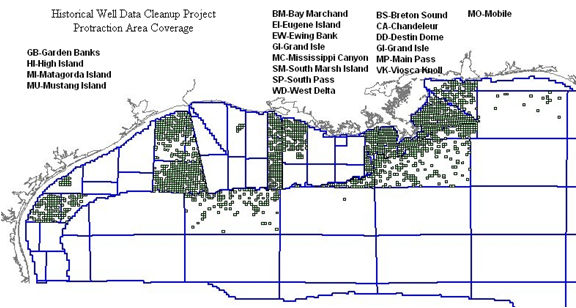Historical Well Data Clean-up(HWDC) Project / Legacy Data Verification Process (LDVP)
Historical Well Data Clean-up
(HWDC) Project / Legacy Data Verification Process (LDVP)
The Historical Well Data Cleanup (HWDC)
project was initiated in 1999 to focus on data quality and availability issues for the Gulf of
America. The project scope was vast and targeted
both the identification and addition of missing well bores (70-series API's), as
well as a review, correction and/or capture of 12 key data types.
Over a 4 year period, the HWDC project reviewed data and documents for ~25,600
wells spanning 19 Gulf of America protraction areas (as below).

The results - a Common Well Header Master (CWHM) record - for each well
reviewed/added were published on this website for two years after the project
was terminated in April 2004. Since that time, the
results of the HWDC project have continued to be harvested as part of ongoing data quality initiatives.
Legacy Data Verification Process
The Legacy Data Verification process (LDVP) was introduced in
2005 as a continuation of the data quality focus and improvements. The overall
objective - all wells correctly positioned with associated data attached - has
not changed; however, greater emphasis is now placed on addressing known or
reported problems, as opposed to working block-by-block across the entire Gulf.
LDVP is a service-based solution that streamlines the flow of
information with tight integration of all the key data quality task areas (e.g.
document imaging, data entry, mapping, quality control, etc) from initial
problem report through to resolution. The introduction of this process has seen
significant efficiency gains and additions and/or corrections are now handled in
a matter of days rather than the months (or even years) of project-based
endeavors. It is also available to both internal and external users (email data
problems to: TDM@bsee.gov).
Major highlights since the introduction of LDVP in January, 2005
include:
- Over 8,444 data problems researched and resolved
- The identification, documentation and addition of ~3,800 wellbores
previously missing from corporate databases (70-series API numbers)
- 33% of these wellbores have log images available
- 14% of these wellbores have associated digital log datasets
(Discovery/addition rate for missing 70-series wellbores is
45/month)
- A review of directional surveys with azimuth and inclination problems
has corrected/eliminated 2,306 spurious data points from the dataset
- Approximately 22, 500 directional surveys have been
updated, edited or input from scanned documents
- Proactive review of data and documents for wells in recent Sale blocks
- 84 wells (70-series API) were reviewed/added for Sale 204
- 160 wells (70-series API) were reviewed/added for Sale 205
- 48 wells (70-series API) were reviewed/added for Sale 206
Common Well Header Master (CWHM) Residual Data
Of the some 3,000 missing wellbores (70-series API) identified
by the HWDC project, 88%
have already been revisited and added to the corporate database. The residual
356 wellbores are still in use for reference and will
be added as and when additional documentation can be located. These are also the
wells targeted by NTL
2010-G03.
At the request of several Gulf of America Data Management Work
Group participants, a list of these wells will be maintained and updated on this
webpage and is available at: http://www.data.bsee.gov/Other/Files/hwdc_not_in_tims.xls.


Follow Bureau of Ocean Energy Management on: